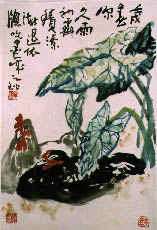Flowers, Insects, and Bird Paintings
Lin K'ai (b. 1924)
Rooster & Hen
Hanging Scroll, Ink and Color on Rice Paper, 26 x 17.5 in., (66 x 44.5 cm.)
 Bird and Flower painting has been a popular style in Chinese traditional art. It goes back at least to the tenth century when court painters painted these subjects which became models for later generations of artists to follow. Outside the Court Academy of Painting some leading literary-scholar painters advanced their own ways of painting this genre. As a result, Bird and Flower painting became second only to landscape painting in national taste. History proves that except a brief time after 1949 when Bird and Flower painting was considered bourgeoisie, this form of painting has existed for the millenium just past. It is still alive and well today.
Bird and Flower painting has been a popular style in Chinese traditional art. It goes back at least to the tenth century when court painters painted these subjects which became models for later generations of artists to follow. Outside the Court Academy of Painting some leading literary-scholar painters advanced their own ways of painting this genre. As a result, Bird and Flower painting became second only to landscape painting in national taste. History proves that except a brief time after 1949 when Bird and Flower painting was considered bourgeoisie, this form of painting has existed for the millenium just past. It is still alive and well today.
Generally, there are two different ways of painting birds and flowers. One is carefully done in detail. The other is rather sketchy with direct application of ink or color. the former tends to be more realistic, elaborate and decorative; the latter, more immediate, spontaneous, playful, and even wild.
To paint in either form requires good training, whether the artist is a professional or amateur.Our painting in this show is done by Mr. Lin K'ai, a remarkable artist and a good man. He was trained at the China Academy of Fine Arts (formerly Hangchow Academy of Fine Arts,) an outstanding national art academy since the thirties. He was a student of Professor Pan Tian-shou, the late former president of the Academy and a well known artist and art historian.
This painting shows Mr. Lin's bold and controlled calligraphic skill, and his humorous portrayal of a rooster and sleepy hen. Don't you think that learning to share the direct feelings and experiences of the artist is our key to understanding and delight? This was the impression Lin painted and has inscribed:
Deep in spring,
After sky clears,
Flood subsides,
by the window I play with the ink.
Purchased in 1992 with funds donated by Martha and Robert Farwell, parents of two alumni.
